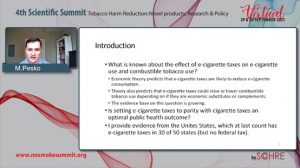In a short introduction Professor Athanassios Vozikis, chair for this session, presented the focus of Professor Michael Pesko’s lecture, which is taxation issues of tobacco products. Prof. Vozikis commented that the role of indirect taxation undoubtedly goes beyond revenue collection as it is a highly effective tool to address either negative externalities associated with the production and consumption of certain products or the achievement of respectively individual policy objectives. Therefore, tax should be differentiated in accordance with the extent of negative externalities to drive demand in the direction of less harmful substitutes.
Professor Pesko first discussed what is already known about the effect of e-cigarette taxes on e-cigarette use and combustible tobacco use. The economic theory suggests that that e-cigarette taxes are likely to reduce e-cigarette consumption. The theory also predicts that e-cigarette taxes could raise or lower combustible tobacco use depending on if they are economic substitutes or complements. In the United States a great part of tobacco policy is passed on a state level. Currently 30 out of 50 states have state level e-cigarette taxes but no federal taxes.
The speaker walked through certain studies that estimated the effect of e-cigarette taxes using sales data. For example, a study used Nielsen retail sales data for 35,000 stores (2011-2017) to estimate cigarette and e‑cigarette price and tax responsiveness. The speaker noted that standardization of e‑cigarette taxes is complicated as different tax schema are used (e.g., excise, ad valorem, sales, and two-tier taxes). Questioning whether taxes increase consumer prices, the speaker stated the importance of economic substitution. Professor Pesko said that we first want to establish that taxes do increase consumer prices and according to the most recent evidence $1 increase in tax, increases the price of an e-cigarette for about $1. In addition, the speaker pointed out that tax parity bills would require a large tax increase on e-cigarettes (as a % of baseline e-cigarette tax rates) and facilitate spillover effects in a much larger marketplace (cigarettes).
Professor Pesko then moved on to discuss the effect of e-cigarette taxation on four age and population groups: teens, young adults, pregnant women, and adults. First, findings amongst teens (under 18) using data from ‘Monitoring the Future’ (2014-2019) showed that a $1 increase in the standardized e‑cigarette tax, reduces current e-cigarette use by 1.9 percentage points, increases current cigarette use by 1.3 percentage points and increases half-pack daily cigarette use by 0.6 percentage points. Approximately 7 in 10 youths who stopped using e-cigarettes due to an e-cigarette tax, smoked traditional cigarettes instead. Second, for the young adults (ages 18-25) the largest rate of substitution was recorded compared to the other age categories. A 1:1 substitution was observed, meaning young adults substitute e-cigarettes for cigarettes nearly interchangeably. Third, approximately 1 in 3 pregnant women that stopped using e-cigarettes due to an e-cigarette tax, smoked cigarettes instead. Lastly, for the adult population under 40 years of age, consistent evidence of substitution was observed. However, for the adult age group over 40, no response was observed to e-cigarette taxation.
Professor Pesko concluded that from an economic perspective, products should be taxed according to their externality and internalities. Alternative policies are necessary other than e-cigarette taxes that would help keep e-cigarettes away from the youth. Finally, improved FDA’s compliance inspection program would reduce access to all tobacco products for youth.


